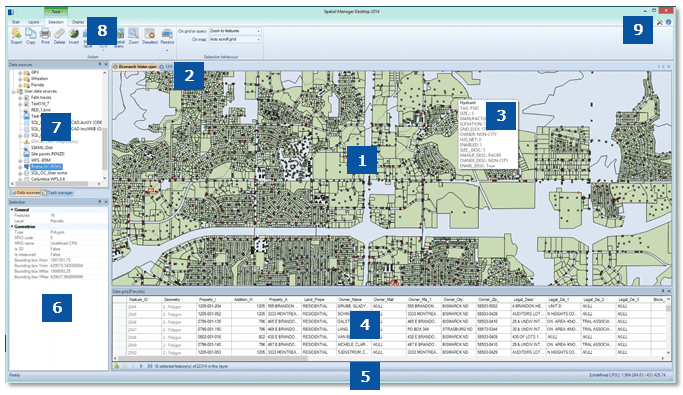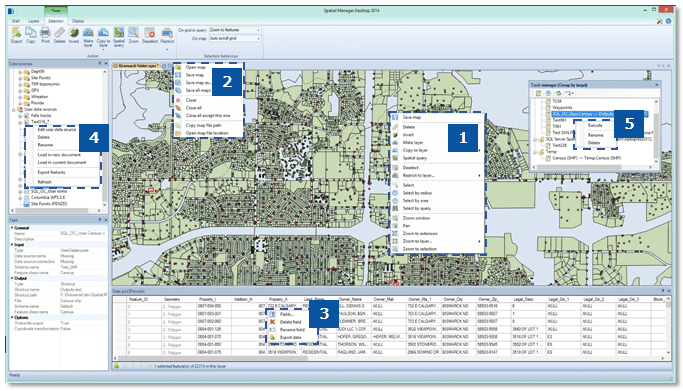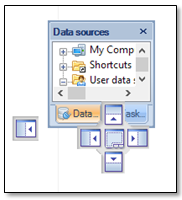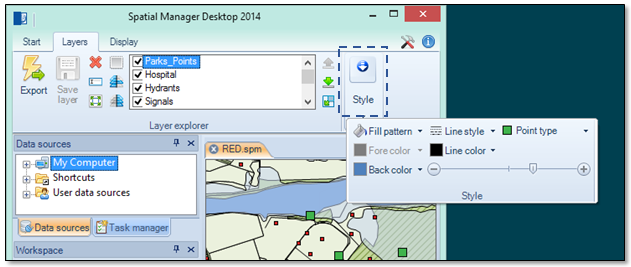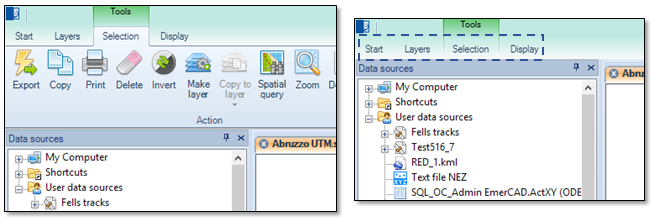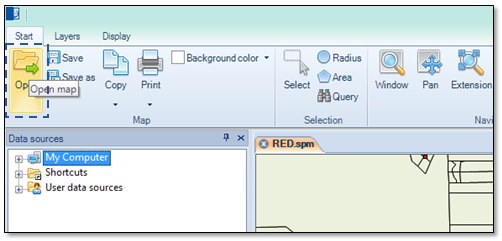Difference between revisions of "Spatial Manager Desktop™ - FAQs: Interface"
| Line 40: | Line 40: | ||
==Application panels== | ==Application panels== | ||
| − | The different panels of the application (Data grid, Properties, Data sources and Task manager) can be arranged, docked, undocked, grouped, self-collapsed, etc., and resized, depending on the preferences and needs of each user | + | The different panels of the application (Data grid, Properties, Data sources and Task manager) can be arranged, docked, undocked, grouped, self-collapsed, etc., and resized, depending on the preferences and needs of each user or each job, by dragging its title bar, using the absolute or relative position arrows, double-clicking on its title bar, etc. |
| − | |||
| − | or each job, by dragging its title bar, using the absolute or relative position arrows, double-clicking on its | ||
| − | |||
| − | title bar, etc. | ||
[[Image:ApplicationPanels.PNG]] | [[Image:ApplicationPanels.PNG]] | ||
| Line 50: | Line 46: | ||
These panels can also be closed. To reopen a closed panel, use the "Display" tab on the ribbon. | These panels can also be closed. To reopen a closed panel, use the "Display" tab on the ribbon. | ||
| − | To quickly restore the default panel layout of the application, use the "Restore position" function from the | + | To quickly restore the default panel layout of the application, use the "Restore position" function from the "Display" tab on the ribbon (the application must be restarted). |
| − | |||
==Ribbon== | ==Ribbon== | ||
| − | The functions available through the Ribbon are separated into tabs containing functional groups. These tabs can be | + | The functions available through the Ribbon are separated into tabs containing functional groups. These tabs can be static ("Start", "Layers", etc.) or contextual, which are only available under some conditions; for example the "Selection \ Tools" tab, when there are selected items. |
| − | + | Different groups in a tab can be found under its normal display (expanded, all icons and functions of the group are visible on the screen) or compressed (a single symbol appears to dropdown the group), depending on the size of the application window and the space available for the components of the ribbon. The expansion or compression of the groups is fully automatic when the application window is resized. | |
| − | |||
| − | |||
| − | |||
| − | Different groups in a tab can be found under its normal display (expanded, all icons and functions of the group | ||
| − | |||
| − | are visible on the screen) or compressed (a single symbol appears to dropdown the group), depending on the size of | ||
| − | |||
| − | the application window and the space available for the components of the ribbon. The expansion or compression of | ||
| − | |||
| − | the groups is fully automatic when the application window is resized. | ||
[[Image:Ribbon1.PNG]] | [[Image:Ribbon1.PNG]] | ||
| − | The ribbon can be set as self-retractable by double-clicking over any of the tabs titles, to expand the space of | + | The ribbon can be set as self-retractable by double-clicking over any of the tabs titles, to expand the space of the application window dedicated to workspaces or the application panels; in this mode, selecting the title of a tab will expand it to show all functions in the tab and will automatically retract it when you select a function. To expand them back again, just double-click over these same tab titles. |
| − | |||
| − | the application window dedicated to workspaces or the application panels; in this mode, selecting the title of a | ||
| − | |||
| − | tab will expand it to show all functions in the tab and will automatically retract it when you select a function. | ||
| − | |||
| − | To expand them back again, just double-click over these same tab titles. | ||
[[Image:Ribbon2.PNG]] | [[Image:Ribbon2.PNG]] | ||
| Line 85: | Line 64: | ||
==First steps== | ==First steps== | ||
| − | Before starting the tutorial exercises, you should quickly review the components of the user interface of the | + | Before starting the tutorial exercises, you should quickly review the components of the user interface of the application, detailed earlier in this chapter. To do so, follow these steps: |
| − | + | *Start the application and open the map "RED.spm", included in the folder "C:\SPM Tutorial\Maps", using the "Open" button on the "Start" tab of the ribbon | |
| − | + | **''Note 1: when opening the map, you will see the evolution of the different map layers loading on the left side of the status line'' | |
| − | *Start the application and open the map "RED.spm", included in the folder "C:\SPM Tutorial\Maps", using the "Open" | ||
| − | |||
| − | button on the "Start" tab of the ribbon | ||
| − | **''Note 1: when opening the map, you will see the evolution of the different map layers loading on the left side | ||
| − | |||
| − | of the status line'' | ||
**''Note 2: "spm" is the extension for Spatial Manager Desktop™ map files'' | **''Note 2: "spm" is the extension for Spatial Manager Desktop™ map files'' | ||
| Line 100: | Line 73: | ||
*Feel free to try out the components of the interface: | *Feel free to try out the components of the interface: | ||
| − | **''Note 3: DO NOT SAVE any voluntary or involuntary changes you may make when running the following tests. The | + | **''Note 3: DO NOT SAVE any voluntary or involuntary changes you may make when running the following tests. The original versions of the map and the layers are used later in the development of the tutorial exercises'' |
| − | + | **Move, dock and undock, group and ungroup or resize the panels of the application by dragging its title bar, using the absolute or relative position arrows, by double-clicking on its title bar, etc. | |
| − | original versions of the map and the layers are used later in the development of the tutorial exercises'' | + | ***''Note 4: reminder - use the "Restore position" function from the "Display" tab on the ribbon (the application must be restarted) to quickly restore the default panels layout of the application.'' |
| − | **Move, dock and undock, group and ungroup or resize the panels of the application by dragging its title bar, | ||
| − | |||
| − | using the absolute or relative position arrows, by double-clicking on its title bar, etc. | ||
| − | ***''Note 4: reminder - use the "Restore position" function from the "Display" tab on the ribbon (the application | ||
| − | |||
| − | must be restarted) to quickly restore the default panels layout of the application.'' | ||
**Move the cursor over the map checking the tooltips of the features included in the layers of the map | **Move the cursor over the map checking the tooltips of the features included in the layers of the map | ||
| − | **In the "Layers" tab on the ribbon, turn the layers off and on again or choose the selected layer (checking its | + | **In the "Layers" tab on the ribbon, turn the layers off and on again or choose the selected layer (checking its effect on the Data grid) |
| − | |||
| − | effect on the Data grid) | ||
**Select features in the map or in the Data grid panel checking the different effects over these components | **Select features in the map or in the Data grid panel checking the different effects over these components | ||
**Review the contextual menus in the different components of the application | **Review the contextual menus in the different components of the application | ||
| − | **Check the Properties panel content when changing the focus on the application (workspace, selected features, | + | **Check the Properties panel content when changing the focus on the application (workspace, selected features, selected layer, etc.) |
| − | |||
| − | selected layer, etc.) | ||
Revision as of 13:38, 12 December 2013
Default layout
1.Maps workspaces
2.Workspaces tabs. Workspace navigation tools on the right side
3.Data tooltip of the feature under the cursor
4.Data grid panel. Navigation, information and other tools on the bottom
5.Status and information line
6.Properties panel. Content varies depending on the active focus (map, source, task, etc.)
7.Data sources and task manager panels (grouped in this picture)
8.Ribbon. Permanent and contextual tabs
9.Other tools (options and preferences, release information, etc.)
1.Workspace
2.Workspaces tabs
3.Data grid panel
4.Data sources panel. Content varies depending on the selected data source
5.Task manager panel
Application panels
The different panels of the application (Data grid, Properties, Data sources and Task manager) can be arranged, docked, undocked, grouped, self-collapsed, etc., and resized, depending on the preferences and needs of each user or each job, by dragging its title bar, using the absolute or relative position arrows, double-clicking on its title bar, etc.
These panels can also be closed. To reopen a closed panel, use the "Display" tab on the ribbon.
To quickly restore the default panel layout of the application, use the "Restore position" function from the "Display" tab on the ribbon (the application must be restarted).
Ribbon
The functions available through the Ribbon are separated into tabs containing functional groups. These tabs can be static ("Start", "Layers", etc.) or contextual, which are only available under some conditions; for example the "Selection \ Tools" tab, when there are selected items.
Different groups in a tab can be found under its normal display (expanded, all icons and functions of the group are visible on the screen) or compressed (a single symbol appears to dropdown the group), depending on the size of the application window and the space available for the components of the ribbon. The expansion or compression of the groups is fully automatic when the application window is resized.
The ribbon can be set as self-retractable by double-clicking over any of the tabs titles, to expand the space of the application window dedicated to workspaces or the application panels; in this mode, selecting the title of a tab will expand it to show all functions in the tab and will automatically retract it when you select a function. To expand them back again, just double-click over these same tab titles.
First steps
Before starting the tutorial exercises, you should quickly review the components of the user interface of the application, detailed earlier in this chapter. To do so, follow these steps:
- Start the application and open the map "RED.spm", included in the folder "C:\SPM Tutorial\Maps", using the "Open" button on the "Start" tab of the ribbon
- Note 1: when opening the map, you will see the evolution of the different map layers loading on the left side of the status line
- Note 2: "spm" is the extension for Spatial Manager Desktop™ map files
- Feel free to try out the components of the interface:
- Note 3: DO NOT SAVE any voluntary or involuntary changes you may make when running the following tests. The original versions of the map and the layers are used later in the development of the tutorial exercises
- Move, dock and undock, group and ungroup or resize the panels of the application by dragging its title bar, using the absolute or relative position arrows, by double-clicking on its title bar, etc.
- Note 4: reminder - use the "Restore position" function from the "Display" tab on the ribbon (the application must be restarted) to quickly restore the default panels layout of the application.
- Move the cursor over the map checking the tooltips of the features included in the layers of the map
- In the "Layers" tab on the ribbon, turn the layers off and on again or choose the selected layer (checking its effect on the Data grid)
- Select features in the map or in the Data grid panel checking the different effects over these components
- Review the contextual menus in the different components of the application
- Check the Properties panel content when changing the focus on the application (workspace, selected features, selected layer, etc.)
